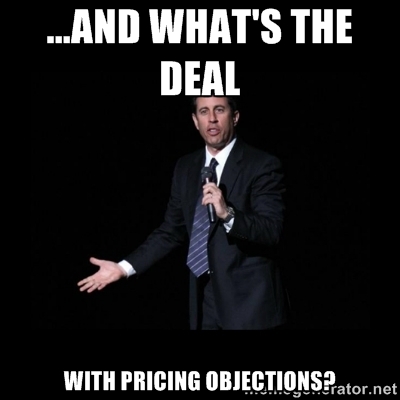 Whether you are self-employed, in upper management or on the road as a sales rep, the last thing you probably want to hear is a rumor about your business, especially one that has the potential to negatively affect you and your company.
Whether you are self-employed, in upper management or on the road as a sales rep, the last thing you probably want to hear is a rumor about your business, especially one that has the potential to negatively affect you and your company.
Most of the time, my clients will come to me directly when they first hear a rumor, be it good or bad. Other times when for instance, I am on a sales call, if seemingly out of nowhere, my client starts to bombard me with questions about our industry and my company’s integrity, I know something serious may be going on. If I have travelled from clinic to clinic to face the exact same questions over and over again, then I know for certain that I must investigate the matter further. This typically happens when I’m trailing the route of a competing sales representative and for the most part, that is part of normal healthy competition. However, sometimes that is not the case at all. It may very well be the beginning of a PR nightmare.
Rumors are a dime a dozen in my industry and I often feel that in any aspect in life, the more successful you are, the more prone you are to attack.
As some of you may be aware, I work for a small business. Although the bulk of my job is in a sales capacity, I am also responsible for all of the marketing, business development and public relations management for the company. This means that as soon as I catch wind of a potentially negative rumor that could affect my company and ultimately my sales, that I need to take that saleswoman hat off, and put my PR hat on. I have to get down to the nitty gritty of it all and devise a plan to sort out all of the facts and relay the correct information to my clients ASAP before the rumor mill gets out of control.
I have to admit that public relations and “damage control” is the most challenging part of my job. The reason being is that I take a lot of pride in my work and the company that I work for and I just can’t stand false accusations, especially when I have to take time away from selling to deal with them. I’ve been with my current employer for so long because of the ethical and upstanding way that the company does business and that is a huge reason for the company’s success. Since its fruition, I have spent several years building and nurturing the business, so when false and threatening rumors start to mill about, I feel like I want to lash out like a Momma bear protecting her cub from a pack of wolves.

…But that wouldn’t be professional, so I digress.
In this article, I will discuss the different types of rumors, why they start and how to stop them from getting out of control and hurting your business.
Note: If you are a sales representative for a corporation and do not have decision making authority, I strongly recommend that you do NOT take matters into your own hands, but rather gather all of the facts you can and immediately report them to your sales manager. Only act under direction of your supervisor otherwise it may cost you your job.
INDIRECT RUMORS:

These rumors although not directly related your company, may have trickle-down effects that can affect your business. I have broken them down into two categories: Industry Related and Mistaken Identity
Industry Related
These rumors come about when a leading company within a specific industry has acted in a manner which has subsequently caused them or a particular product to receive negative publicity. If such acts have caught the attention of national or even international media, this may instill fear in the consumer who does not use the company in question but does conduct business in the same industry.
For example, several years ago one scientific study published results which claimed that people who supplemented with Vitamin E had higher mortality rates than those who did not. Even though this study was very poorly done and was not conclusive, the media blew it out of proportion and broadcasted that “Vitamin E Kills”. My father, who owns a nutrition store, saw a huge decrease in his Vitamin E sales as a result even though it had nothing to do with his business or a certain brand of product that he sold.
Unfortunately, in these cases the business owner or sales rep ends up on the defense, having to defend the legitimacy of the product or service they are selling. In business, the best practice to overcome these random and potentially harmful rumors is to be proactive. Ensure that you are routinely keeping up with current events in your industry and regularly educating your clients so that they will trust and value your opinion rather than succumb to the latest gossip.
Mistaken Identity
These rumors most often involve a direct competitor and can be quite a nightmare to straighten out. For instance, let’s say in a niche industry where you may have two main competitors who may even have very similar company names (i.e. ABC Corporation and ACME Corporation), if one of those companies were to be exposed for having done something illegal or unethical, the other companies may be “guilty by association”. In these cases, clients may easily confuse which company is “the bad guy” sort-to-speak or just be reluctant to use any of those companies out of fear that they may all be conducting business in the same manner.
If this happens to your business, the best thing to do is to get in front of your customers either face-to-face or by means of intense advertising to remind them of your business and what sets you apart from your competition. Remind them of your excellent quality, service or whatever it may be. Keep your head up, keep it positive and act like you are unaffected. Playing your cards right in this situation may end up increasing your sales, especially if you can take some of that business from your competition.
2. DIRECT RUMORS (Targeted)

This is an unethical, malicious attack conducted by an individual or an organization intended to harm a business. It is also illegal and violates many codes of professional practice. Although these types of rumors are rare, they do happen. I have seen this behavior in sales representatives, business professionals, and even some companies who do this in a desperate attempt to “win” back their market share. If you have ever considered doing this, don’t! The egg will wind up on your face.
I hate dealing with these cases because it is such an absolute waste of everybody’s time. If you fall victim to this childish behavior, just laugh it off and clarify the facts. If you have a solid relationship with your clients, they will believe you. If the accusation is a serious potential threat to your business, then you will need to devise a solid PR strategy and may need to obtain legal advice.
If you are faced with any of these types of rumors or perhaps one I haven’t mentioned, follow these general steps to stop the rumor mill before it gets out of control:
- Qualify the Rumor: Is it a legitimate threat to your business? If not, just laugh it off. If it could be, proceed to step 2
- Find The Facts: In speaking with the person who brought the rumor to your attention (and no one else), ask the 5W’S: WHO,WHAT, WHEN, WHERE and WHY. Document everything in detail. Do NOT provide your opinion or commentary prematurely as that could further harm your business.
Some examples of questions to ask could be:
WHO did they hear it from? Was it first hand? Or second hand? Make note of any names in case someone may be guilty of slander. Knowing how far off from the source your client heard the rumor could give you valuable insight into how far it has already spread and how much damage could have potentially been done.
WHAT exactly did they hear? Be as specific as possible. Was it something that was covered in the media recently? Was someone in particular saying bad things about you or your company? Or is your client just worried about something in general?
WHERE did they hear this? Were they amongst other clients of yours?
WHEN did they hear it? If it was a long, long time ago, it likely isn’t relevant anymore. If it was recently, how recently? Rumors spread very quickly, so if you are the first person they talked to about it, you have a good chance at grinding that rumor mill to a halt before it gets going.
WHY did someone say the things they did? Did the person sharing these rumors with your client share them out of concern or ill intent?
- Decide on the Most Appropriate Medium(s) to Present the Facts: This will depend on your specific type of business. Will you create a press release? Or target specific clients? Will you discuss it face-to-face? Or simply via a letter or email?
- Bombard Your Clients with The Facts: You can use one type of media or several. Regardless, make sure that your clients are crystal clear about the situation at hand.
- Consult a Lawyer if Necessary. If you are dealing with an individual or corporation who may be slandering you or your company, you should obtain legal advice.
I hope that none of you have to deal with these types of scenarios in business, but if you do, I hope you keep this article as a handy reference and find these tips helpful in grinding that rumor mill to a halt!
Happy sales my friends and remember to keep your head up and be professional!
Cheers,
TSW
 This is the most important line in your email since most emails are deleted without opening based on the subject line alone. Make it as succinct and relevant as possible to the reader.
This is the most important line in your email since most emails are deleted without opening based on the subject line alone. Make it as succinct and relevant as possible to the reader. In this section, in 1-2 sentences maximum, address the following:
In this section, in 1-2 sentences maximum, address the following: In 1-2 sentences (3 maximum), outline the purpose of your email. This can be a brief description of the business opportunity you wish to discuss. Do NOT be tempted to get into your sales pitch here! Simply address the following:
In 1-2 sentences (3 maximum), outline the purpose of your email. This can be a brief description of the business opportunity you wish to discuss. Do NOT be tempted to get into your sales pitch here! Simply address the following: Once again, limit this to ideally 1 sentence:
Once again, limit this to ideally 1 sentence:

















